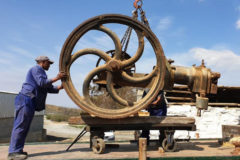The Manitowoc story
Posted by Chris Graham on 15th December 2020
Keith Haddock concludes the Manitowoc story, explaining how it survived to become America’s No.1 crane builder.
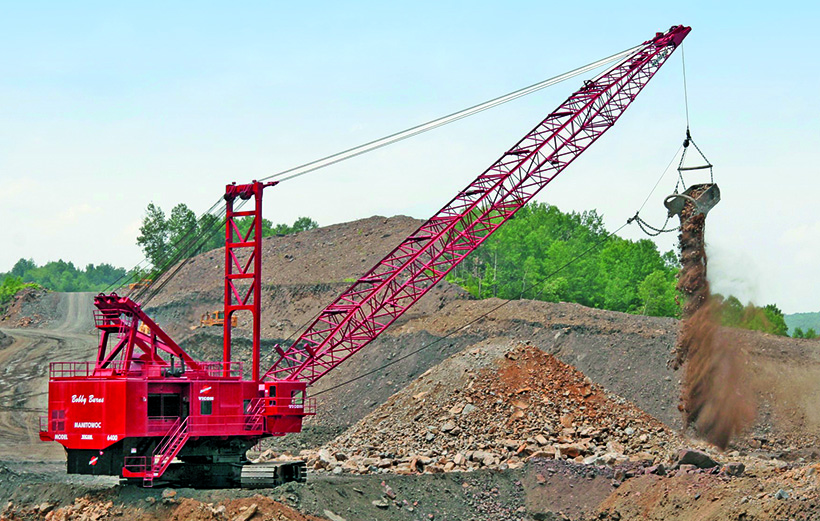
The Manitowoc story: This 6400 carries a 16-cubic-yard bucket on a 160-foot boom, and is seen at work uncovering anthracite in Pennsylvania.
Having achieved great success with its seven-yard 4600 excavator, and listening to demands from its American coal-stripping customers, Manitowoc introduced the 6400 dragline in 1977. Carrying a 16-cubic-yard bucket on a 160-foot boom, its capacity was more than double that of the smaller machine. Like the 4600, the 6400 boasted two engines but, this time, one was mounted in the lower works to power the propel. The upper engine – a V16 Cummins diesel rated at 1,600hp – drove the hoist and drag through VICON control, and also the swing motion.
The lower engine, a Cummins six-cylinder diesel rated at 450hp, provided independent, hydraulic drive via gear reductions to each crawler. This engine drove two, variable-displacement, reversible hydraulic pumps which ran two hydrostatic motors in each crawler assembly; an arrangement that eliminated conventional drive chains and allowed counter-rotation of the crawlers.
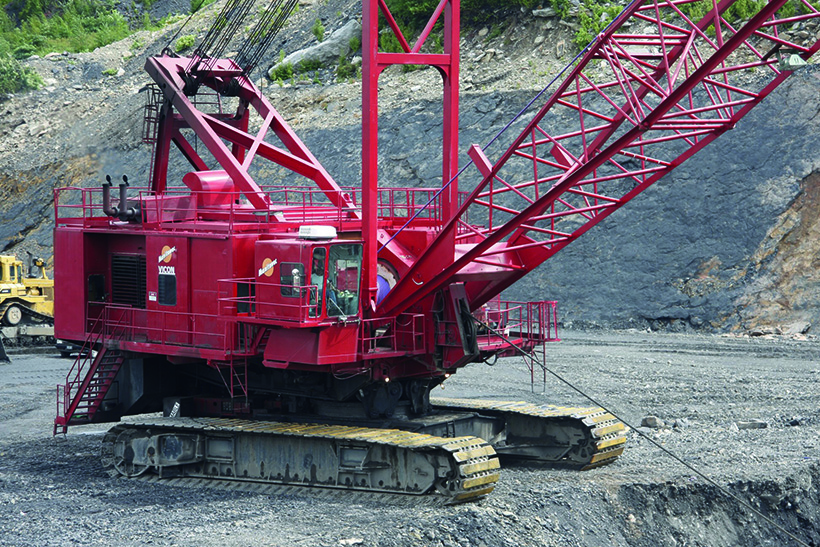
The 6400 is a diesel-powered dragline with two engines, one in the lower works for propel.
The upper machinery included VICON control for hoist and drag, as mentioned, but also boasted hydraulic swing and boom hoist systems. Swing motion was via two hydrostatic motors positioned on opposite sides of the swing gear, each powered by a variable-displacement, reversible hydraulic pump. A similar hydrostatic motor and reversible hydraulic pump drove the independent boom hoist, via a twin-drum, worm-driven arrangement.
Probably due to the complicated arrangement of mechanical and hydraulic systems requiring additional maintenance, sales of the 6400 reached only 14 units. Shephard Hill & Company operated one at its Low Close opencast site in Cumbria. But the machine didn’t exactly receive ‘glowing’ praise and, after being rebuilt, was sold back to America. Despite these problems, some companies persevered and ‘learned’ how to run the 6400 profitably. Two were operated until recently by Peabody Energy at two of its coal mines in Wyoming, and Keystone Anthracite Company still operates three in eastern Pennsylvania today.
America’s No.1 crane-builder
By the end of the 1970s, Manitowoc boasted cranes and excavators working worldwide, from Saudi Arabia to Singapore, from the North Sea to the southern tip of Africa. Crane sales sky-rocketed from $18 million in 1960, to $160 million in 1980. Exports accounted for 36% of total sales.
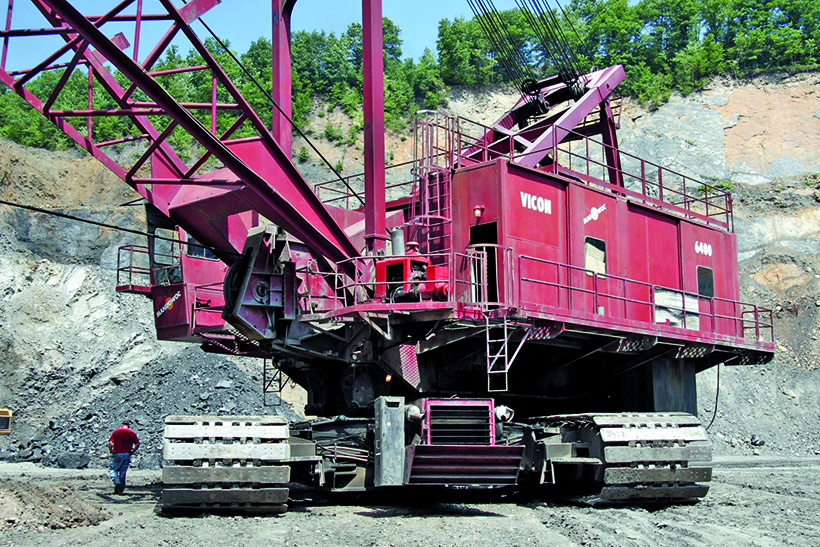
Showing the undercarriage of the 6400, and the diesel engine that powers the hydrostatic propel.
A benchmark crane announcement came in 1969, when Manitowoc introduced the new 4100W. Not only was this an advanced-design crawler crane of 200 tons capacity, it was also optionally adaptable to the company’s innovative Ringer concept. The Ringer assembly consisted of a large roller path encircling the crawlers, on which the crane revolved. It provided the crane with a wider base that more than doubled the standard capacity, and eliminated the need for cranes of different sizes on site.
The 4100W Ringer could handle booms up to 340 feet long, plus a fly jib of 50 feet. A further adaption was the Traveling Ringer, where the entire assembly could be adapted to move on crawler tracks. The machine boasted 300 tons lifting capacity in this configuration.
Following the success of the 4100W, Manitowoc developed larger and larger cranes over the years. The first 6000W was launched in 1974, as a 425-ton crawler crane, then it was upgraded in 1978 to the Series 2, with a 500-ton capacity. This was claimed to be the world’s largest crawler-mounted lift crane at that time.
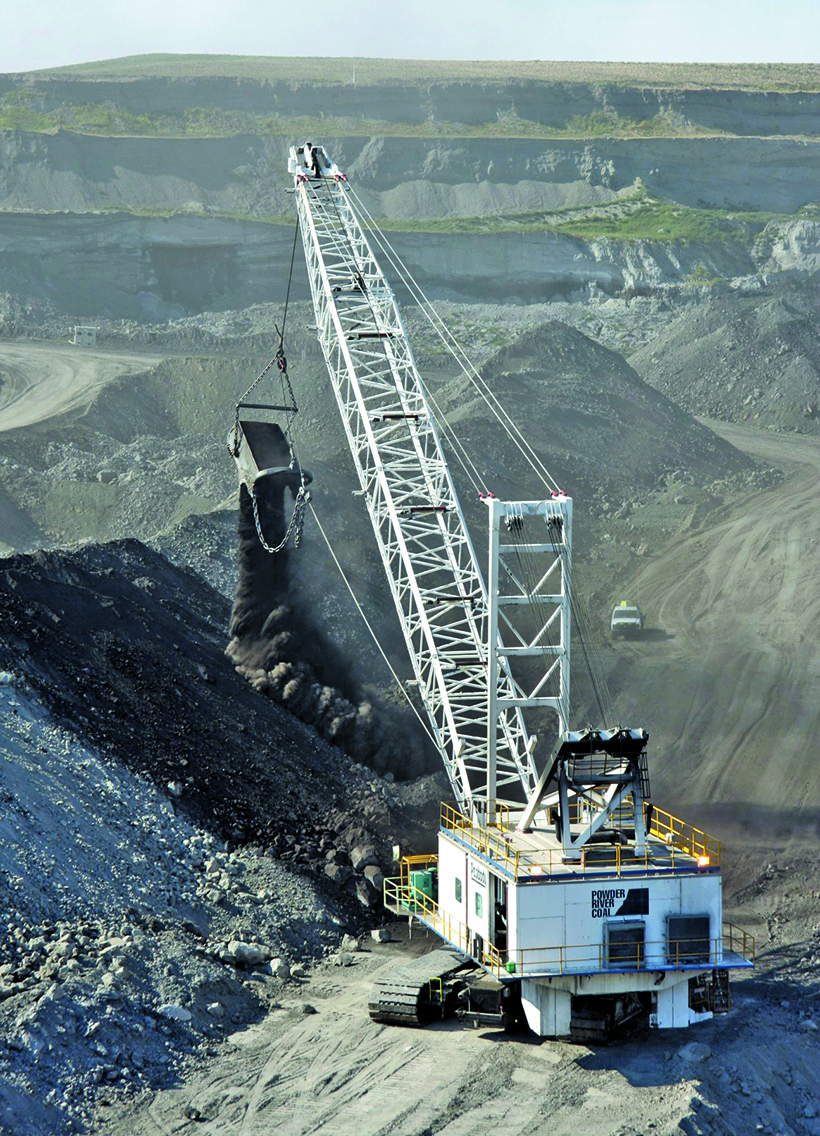
Peabody Coal operated two Manitowoc 6400 draglines at its mines in Wyoming.
Meanwhile, the smaller 4600 transformed into lift crane options. A 1975 bulletin for the 4600 read: ‘Series 1 for excavation shovel or dragline; Series 2 for lift crane applications uprated to 240 tons capacity; Series 3 for combination dragline, grab or crane up to 240 tons capacity, also adaptable for 60-foot diameter Ringer operation.’
Manitowoc survived the early 1980s recession by cutting back on manufacturing space, re-manufacturing cranes and paying-down debt. Crane sales had dropped 60% from 1980 to 1984. So, beginning in 1985, the company introduced a new line of cranes. Known as the M-series, they were marketed as ‘basic at an economic price’ with few extras, and incorporated a light-duty undercarriage. They were easy to transport, quick to erect, and featured a modern, full-hydraulic power system with electro-hydraulic controls. The first three models were the M-50W, M-65W and the M-80W, with capacities of 60, 75 and 90 tons respectively. The M-65W was introduced to the European market at the Haydock Crane Show in May, 1990. M-series machines were also available for dragline service.
Remembering its coal-stripping customers who brought much business to the company by servicing and supplying parts to the hundreds of 4600 excavators still at work, Manitowoc introduced a new crawler dragline in 1985. The 3950D could handle a six-yard bucket on a 100-foot boom, and was designed for easy shipment with modular construction. Either 420hp, optional Caterpillar or Cummins engines powered its motions, through Vicon control.

This Manitowoc 2900 truck crane is owned by MJ Spott Equipment Rental, of Scranton, Pennsylvania.
Crowning glory
The M-series’ crowning glory was the introduction and demonstration, in 1992, of the M-250 with a 275-ton lifting capacity – the largest in the series. It was able to completely dismantle itself without the assistance of a second crane, in only one hour and 40 minutes.
By 1996, Manitowoc’s crane range consisted of 20 crawler cranes from 100 to 600 tons maximum capacity, nine enhanced-capacity models (Ringers and Platform Ringers) from 250 to 1,433 tons capacity and a 300-ton truck crane. These included the very successful model 888 crawler crane launched in 1995. Basically replacing the 4100W, this could handle 230 tons as a standard crawler crane, but was able to extend its lifting capacity to 660 tons with Manitowoc’s patent Ringer attachment. The large, American crane company, Essex Crane Rental, based in New Jersey, whick operated a Manitowoc-only crane fleet, ordered 30 of the new cranes, even before the first one had been built!

The 3900T truck crane could lift 155 tons at 12-foot radius with outriggers in position. It was mounted on a 12×6 carrier.
Significant acquisitions
Major changes have taken place with the Manitowoc company over the past three decades, as the emphasis gradually moved away from excavators and all other businesses, and it become a specialised crane company. In 1998, Manitowoc bought USTC, a manufacturer of boom trucks and rough-terrain forklifts, to complement its existing Manitex boom trucks built at its Mexican factory.
French company Potain, a world leader in design, manufacture and supply of tower cranes, was acquired by Manitowoc in 2001. At that time, Potain was market-leader in France and Italy, and the second largest in Germany. It operated eight factories across Europe, plus one in China, where its market had been developing since 1991.

This 777T, with a lifting capacity of 182 tons, is mounted on a 10×6 truck. It features rolling outriggers enabling it to move with a load (on a firm, smooth surface, of course!).
At Conexpo 2002, in Las Vegas, Manitowoc announced it was taking over Grove Cranes and its extensive line of truck, telescopic, rough terrain, industrial and carry-deck cranes. Grove had already taken over British crane manufacturer Coles Cranes with its Sunderland factory, in 1984. Founded in 1879, Coles had earlier acquired several crane builders itself, such as RH Neal & Co of Grantham, and F Taylor & Sons of Manchester. In the early 1960s, Coles truck-mounted cranes up to 140 tons capacity, were some of the largest in the world.
Also in 2002, Manitowoc acquired National Crane, a company specialising in telescoping-boom truck cranes. This company, founded in Nebraska, USA in 1947, began by manufacturing roadside weed-sprayers, adding hydraulic boom trucks in the 1960s. Since 2002, Manitowoc Crane Group has been advertising its cranes under the recognised brand names: Manitowoc, Grove, Potain, National and Manitex.
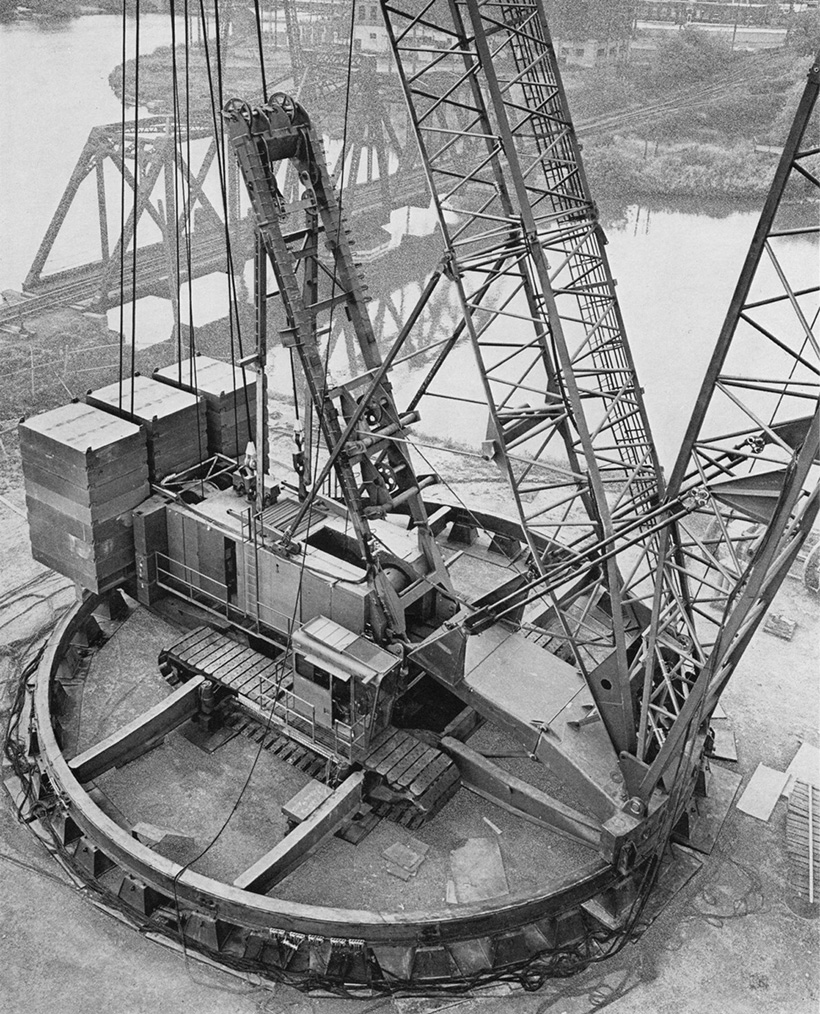
This view shows how the Manitowoc patented Ringer is set up with the external roller circle carrying boom and counterweight. A mobile version with crawler tracks is named the Travelling Ringer.
In 2004, Manitowoc and Japan’s Kobelco developed a joint agreement for Kobelco to supply Manitowoc with a range of crawler cranes of under 150 tons capacity. These would be branded as Manitowoc, and form the lower end of the company’s extensive crane line. A 2007 general catalogue lists five crawler crane models, from 80 to 120 tons, and 10 models with basic capacities from 132 to 834 tons.
Booming business
Manitowoc’s booming crane business included two very large cranes that pushed the limits. The first was a model 21000 which appeared in the iron at Conexpo 1999, in Las Vegas. As a basic crane, it could lift 834 tons but, when working with the Manitowoc Max-ER, capacity increased to 1,000 tons at 45-foot radius. The Max-ER consists of a very large counterweight, in the form of a separate structure attached to the rear of the machine. Connected to the main boom via an intermediate or mast, it runs on rubber tyres as the machine revolves.

The Manitowoc 111 was one of the company’s ‘West’ series of all-hydraulic crawler cranes. A load of 80 tons could be carried at 10-foot radius, on a 40-foot boom.
Distinguishing the 21000 from other cranes is its unique undercarriage, consisting of four, dual-crawler modules; a design aimed to evenly distribute ground loading, and make the crawlers easier to transport. The eight crawler tracks look similar to those of the lower works of a stripping shovel, but the crawler assemblies don’t steer independently, as on the shovels. The first two 21000 cranes were ordered in 1998 by All Erection & Crane Rental Corp. of Cleveland, Ohio, and put to work the following year.
The second massive crane appeared in 2009. This was the 31000, with a maximum lifting capacity of 2,500 tons. Still current today, this crane’s most interesting feature is its Variable Position Counterweight (VPC); a moveable counterweight suspended from the rear of the crane, but not relying on the ground to support it like the Max-ER type just described.
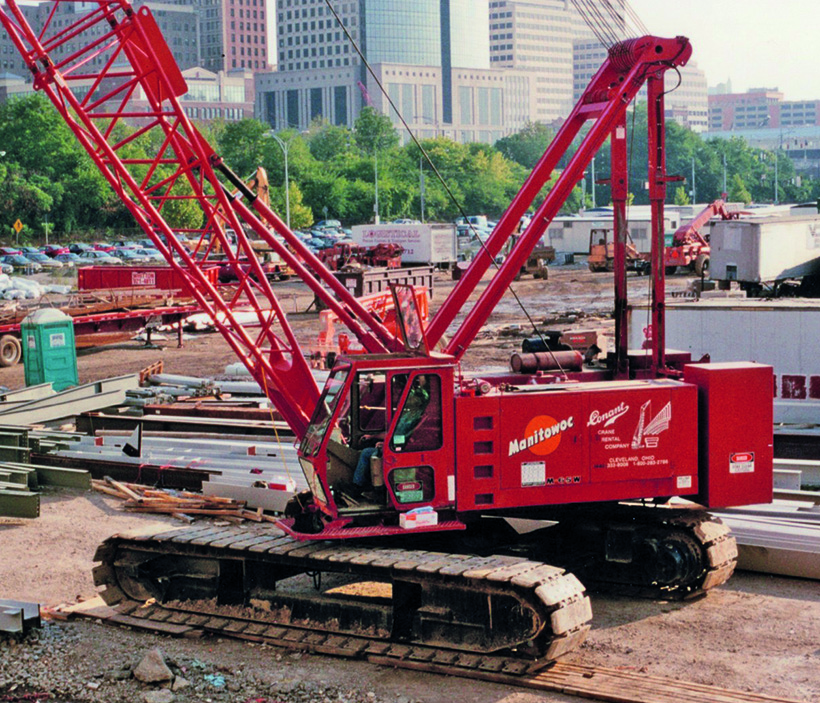
Manitowoc’s M-Series is represented here with the M-65W. It was introduced to the European market at the Haydock Crane Show, in Manchester, in May 1990.
The self-supporting counterweight is attached to a lever arm which automatically moves it outward to balance the crane as the hook load increases, or boom angle changes. Using a hydraulic cylinder, the intelligent system moves the counterweight based on a combination of load and boom angle. Because the VPC never touches the ground during lifting, it reduces the amount of ground preparation needed when compared with other methods. It also allows for pick-and-carry of all rated loads, making it easier to manoeuvre around a site.
Like the smaller, 21000 model, the 31000 crane travels on four crawler modules, but the larger machine employs only one track assembly at each corner, instead of two. Two 600hp Cummins diesels deliver the power. Manitowoc says this crane can be moved in 85 truckloads, and be erected in 12 days with help from a 300-ton crane and auxiliary equipment.

This is the successful model 888 crawler crane, launched in 1995 to replace the older 4100W with basic lifting capacity of 230 tons. Crane hire company Essex of New Jersey, ordered 30 before the first one was even built!
Manitowoc today
Over the past decade, consolidation has been the key word, with Manitowoc parting with some of its manufacturing segments. But each corporate move has strengthened the company’s capability to move forward as a crane specialist. The shipbuilding division, now known as Manitowoc Marine, and part of the company’s business since its founding in 1902, was sold in 2008 to Italian shipbuilder Fincantieri. This division had successfully completed many important contracts for construction and repair of dredging equipment, barges, container ships self-unloading vessels and submarines.
In 2016 Manitowoc ‘spun off’ its food service equipment operations, known then as Manitowoc Foodservice, and consisting of 23 global brands that included 12 holdings boasting either number 1 or 2 position in their respective markets. The newly-formed company, with products rebranded Welbilt, continues as a leader in ice machines and many other types of food service equipment. This action left Manitowoc Company as a stand-alone company specialising in most types of cranes.

This photograph shows the 21000 set up with a 180-foot main boom, plus 300-foot fly jib, lifting 43 tons at 305 feet radius. The Max-ER counterweight attached to the crane moves on its own wheels, as the crane revolves.v
As already mentioned, Manitowoc is the only American-owned crane manufacturer established in the 20th century whose name can still be found on current machines sold today. So how could this company survive wars, depressions, recessions and takeovers for almost 120 years? Well, here are five possible reasons: 1. Following the two world wars, it planned its post-war strategy to avoid the boom-and-bust syndrome. 2. It broadened its market by diversifying into different products when necessary, so that one market recession didn’t hurt the entire company. 3. It didn’t fall into the trap of venturing into hydraulic excavators – the downfall of so many other rope excavator manufacturers. 4. Early on, it made a strong presence overseas, especially in Europe with overseas manufacturing facilities. 5. It kept pace with other world-class builders of high-capacity cranes, especially in times of heavy demand, such as the Arab oil embargo and the rush to build off-shore oil platforms in the 1970s.
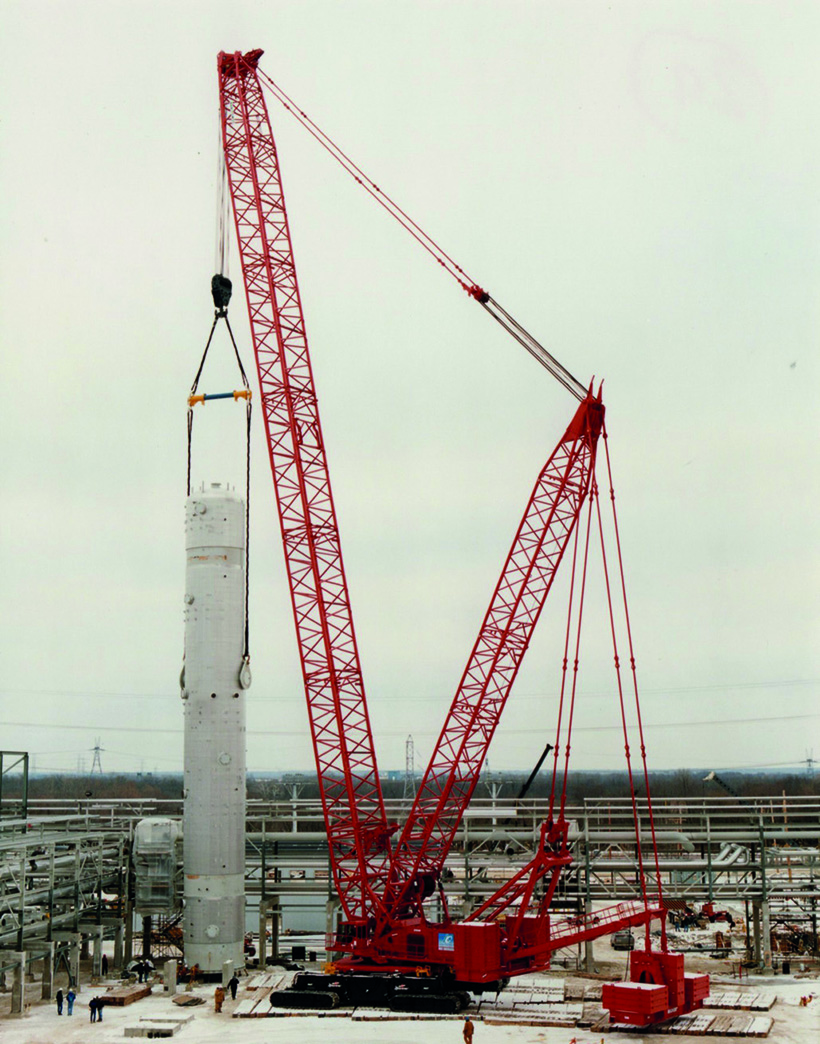
This 21000 is set up with Max-ER system to lift 1,000 tons.
By purchasing other crane-makers such as Grove, Potain, and National, Manitowoc still thrives today as an American-owned company, and builds some of the largest cranes available in the world. At Conexpo 2020, Manitowoc presented its new MLC150-1, a 165-ton capacity crawler crane, and the Grove-influenced GHC140, the company’s latest and largest telescopic crawler crane of 140 tons capacity.

Manitowoc’s flagship crane, and one of the world’s largest, is the 31000, that’s rated at 2,500 tons maximum lifting capacity. It features the patented Variable Position Counterweight suspended from the rear of the machine. This automatically moves outward, keeping perfect balance as hook load increases or boom angle changes.
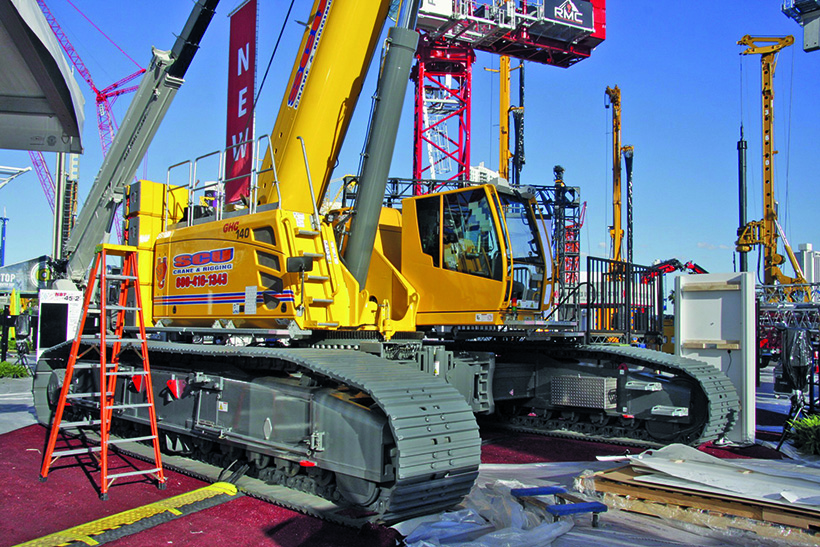
Here, under final assembly, is one of Manitowoc’s machines displayed at the recent Conexpo 2020 show, in Las Vegas – the GHC140.
For a money-saving subscription to Old Glory magazine, simply click here




